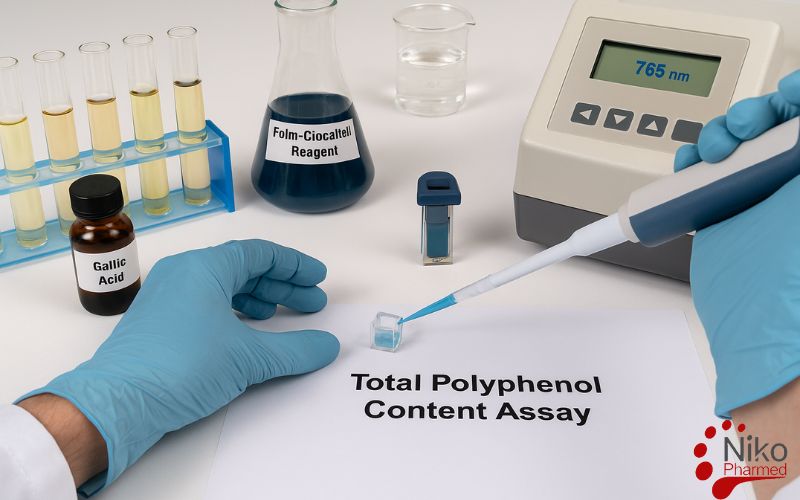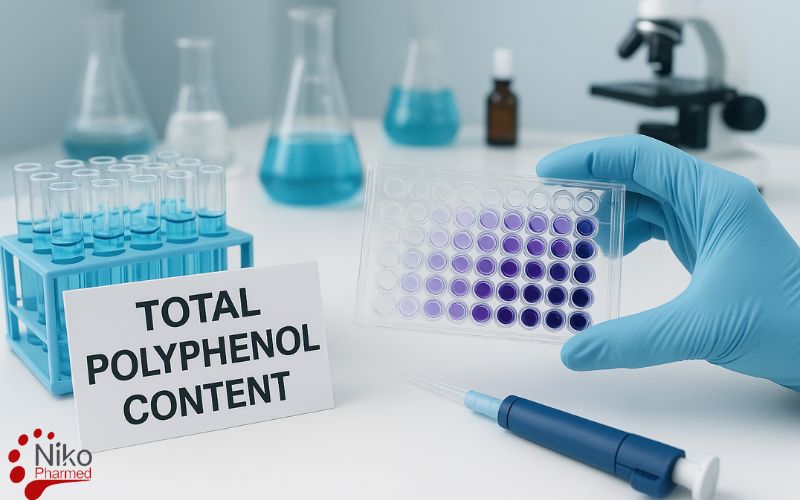What is Total Polyphenol Content Assays (TPC)?
Total Polyphenol Content Assays are standardized analytical procedures used to quantitatively determine the overall concentration of polyphenolic compounds in a sample, typically expressed in terms of gallic acid equivalents (GAE) or catechin equivalents (CE).
Polyphenols are a diverse group of naturally occurring secondary metabolites in plants, characterized by the presence of multiple phenolic structural units. They are of considerable interest in food science, pharmacology, and nutraceutical industries due to their antioxidant, anti-inflammatory, and health-promoting properties.
Total Polyphenol Content Assays (TPC) Procedure
Principle and scope
Polyphenols in an extract reduce the phosphomolybdotungstate complexes of the Folin–Ciocalteu reagent, producing a blue chromophore with a broad absorption maximum at 765 nm. Signal is quantified against a gallic acid calibration curve and results are typically expressed as gallic acid equivalents (GAE) on a dry-matter basis. ISO 14502-1 formalizes this method for teas; AOAC SMPR 2015.009 specifies performance requirements for dietary supplements and related matrices. In routine practice, these absorbance measurements are performed using dedicated UV–Vis spectroscopy platforms validated at 765 nm for Folin–Ciocalteu assays.
Reagents
Water, Type I (per ISO 3696).
Methanol (analytical grade) and methanol/water (70% v/v) extraction mixture.
Acetonitrile (for instant tea stabilization in ISO scope).
Folin–Ciocalteu phenol reagent; prepare a 10% (v/v) diluted working solution fresh daily.
Sodium carbonate, 7.5% (w/v) aqueous solution.
Gallic acid monohydrate for calibration standards (prepare 10–50 µg/mL series on day of use).
Apparatus
Analytical balance (±0.001 g), water bath (70 ± 1 °C), centrifuge (~2000 RCF), spectrophotometer at 765 nm (10 mm path), class-A glassware, vortex mixer, and clean plastic or acid-washed glass tubes (prevent trace organic contamination).
Sample preparation (matrix-dependent examples)
Tea leaves (ISO method): Grind homogenously. Extract 0.200 g with 2×5 mL of 70% methanol at 70 °C for 10 min (vortex at 5 and 10 min), combine, centrifuge, and bring to 10 mL with extraction solvent. Store at 4 °C ≤24 h; equilibrate to RT before assay. Prepare a 1:100 dilution in water for color development.
Instant tea (ISO method): Dissolve 0.500 g in warm water (≤60 °C), cool, add 5 mL acetonitrile, dilute to volume; then 1:100 dilution for assay.
(For other botanicals/foods, use a validated extraction appropriate to the matrix; method performance must meet AOAC SMPR criteria.)
Calibration
Prepare gallic acid standards (e.g., 10, 20, 30, 40, 50 µg/mL). Take 1.0 mL of each standard (in duplicate) through the full color development (Sections 7–8). Plot blank-corrected absorbance at 765 nm versus mass (or concentration) of gallic acid; fit a linear regression (r² ≥ 0.995 recommended).
Color development (Folin–Ciocalteu reaction)
In duplicate tubes for each standard, blank (water), and sample dilution:
- Add 1.0 mL analyte (or water for blank).
- Add 5.0 mL of 10% (v/v) Folin–Ciocalteu reagent; mix.
- Within 3–8 min, add 4.0 mL of 7.5% (w/v) Na₂CO₃; cap and mix.
- Incubate 60 min at room temperature (protected from strong light).
- Measure A₇₆₅ in 10 mm cuvettes against water.
Calculation and expression of results
- Obtain the mass (or concentration) of gallic acid corresponding to each sample’s absorbance from the calibration curve.
- Correct for all dilutions and express as mg GAE per g sample on a dry-matter basis. ISO 14502-1 provides the calibration and dry-matter corrections; moisture (loss at 103 °C) should be determined as specified. For solid products, dedicated Moisture Content Analysis is performed in parallel so that total polyphenol values can be consistently expressed on a dry-matter basis
Typical reporting unit: mg GAE g⁻¹ (dry basis), with the calibration range used, number of replicates, and uncertainty/precision.
Quality control and performance (per AOAC SMPR 2015.009)
- Analytical range: 5–500 ppm GAE (method must demonstrate linearity across intended range).
- LOQ: ≤ 5 ppm GAE.
- Recovery: 80–110% (spike-recovery in the working matrix).
- Repeatability (RSDr): ≤ 9% at 3–5 ppm; ≤ 7% above 5 ppm.
- Reproducibility (RSDR): ≤ 13% at 3–5 ppm; ≤ 10% above 5 ppm (for multi-lab studies).
Include reagent blanks and check standards at low and mid-range in each batch; evaluate matrix effects and potential interferents.
Known interferences and precautions
The F–C reagent is reduced by any readily oxidizable species (e.g., ascorbate, sulfites, some sugars/proteins), so results reflect “total reducing capacity” rather than phenolics exclusively; interpret as “total (poly)phenols (GAE).” Validate specificity for your matrix or use orthogonal methods when necessary.
Maintain consistent reaction time, temperature, reagent age, and ionic strength; deviations shift color yield and bias results. ISO specifies 60 min at RT and 765 nm detection.
Use clean plastics or acid-washed glassware; trace contaminants can elevate blanks.
Method suitability and alternatives
The ISO 14502-1 procedure is matrix-validated for tea and widely adapted elsewhere; when extending to other foods or botanicals, verify extraction efficiency and demonstrate compliance with AOAC SMPR performance targets in that matrix.
Other colorimetric assays exist (e.g., Fast Blue BB) but are different chemistries and require their own validation; do not mix calibration or performance criteria.
Nikopharmad Total Polyphenol Content Assays (TPC) Laboratory
Accreditation and Global Recognition
At Nikopharmad, our Total Polyphenol Content (TPC) analysis is performed under ISO/IEC 17025 accreditation and ILAC recognition, ensuring full compliance with internationally recognized standards of analytical quality and technical competence. Our credentials confirm that polyphenol quantification results meet the highest global regulatory and scientific requirements, accepted by AOAC International, ISO 14502-1, Codex Alimentarius, and leading research institutions worldwide.
Technical Excellence and Validated Infrastructure
Our state-of-the-art analytical facility is equipped with advanced instrumentation, including UV–Vis spectrophotometers optimized for the Folin–Ciocalteu assay, HPLC/UPLC systems for polyphenol profiling, and LC-MS/MS for confirmatory analysis. We follow validated methodologies (e.g., ISO 14502-1:2005, AOAC SMPR 2015.009), supported by strict environmental controls, calibrated instruments, and standardized extraction protocols to safeguard sample integrity from collection to reporting.
Regulatory-Ready Reporting and Timely Results
In both research and regulatory contexts, timely and reliable polyphenol data is critical. Nikopharmad delivers TPC results with full method validation records, traceable raw data, and statistically analyzed results suitable for scientific publication, regulatory submission, and quality control documentation. Our optimized workflow ensures fast turnaround times without compromising accuracy or compliance—supporting product development, nutritional labeling, shelf-life studies, and functional food claims.
Confidentiality and Data Integrity
We prioritize client confidentiality and data security. All TPC testing activities are conducted under strict non-disclosure agreements and recorded in 21 CFR Part 11-compliant electronic data systems. A complete audit trail is maintained for every analysis, ensuring integrity, reproducibility, and traceability of results. Proprietary formulations and research data are handled with the utmost professionalism and ethical responsibility.
Competitive Pricing with Uncompromised Quality
We offer competitive and transparent pricing for Total Polyphenol Content testing, supporting startups, SMEs, and multinational corporations. Our cost-effective analytical solutions accelerate market readiness and regulatory approval, while ensuring compliance with international method performance standards and delivering uncompromised scientific accuracy.
To request testing or a complimentary consultation contact Nikopharmad
Partner with Nikopharmad for Expert total polyphenol content
By partnering with Nikopharmad, you gain access to a globally accredited laboratory committed to scientific excellence, regulatory compliance, and confidentiality. Whether verifying polyphenol levels for health claims, ensuring batch-to-batch consistency, or validating stability during storage, our expertise in TPC assays—anchored in ISO and AOAC standards—ensures accurate, reproducible, and internationally recognized results, enabling you to achieve faster, compliant, and confident market access.


